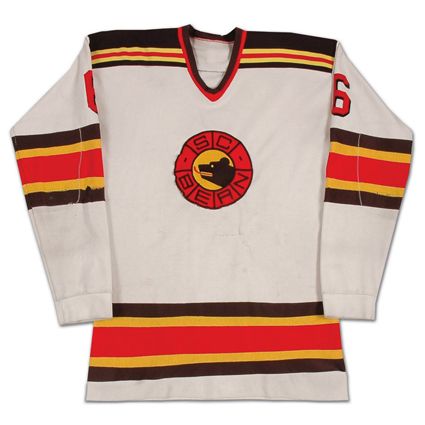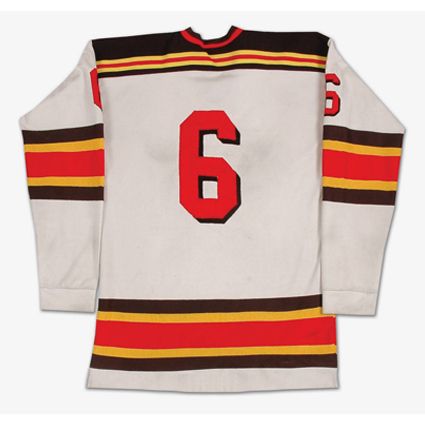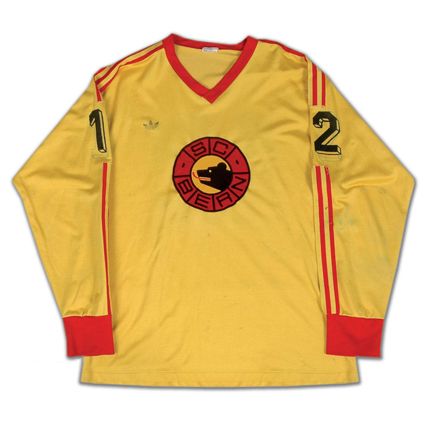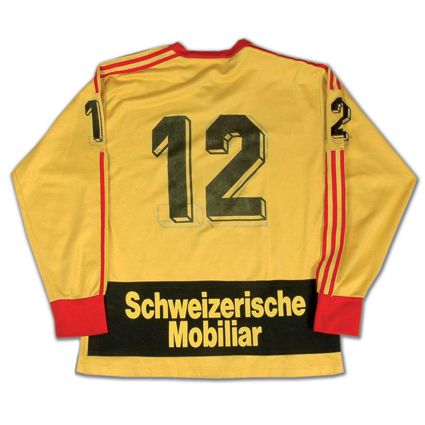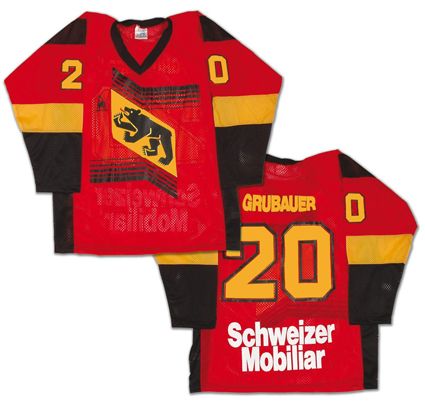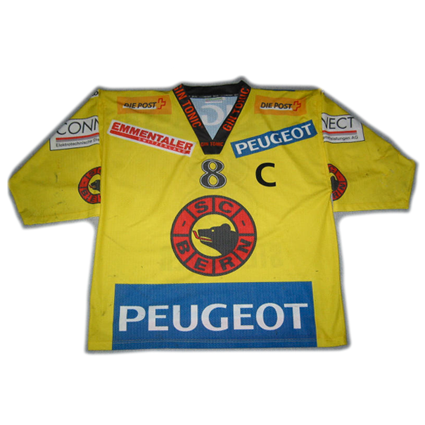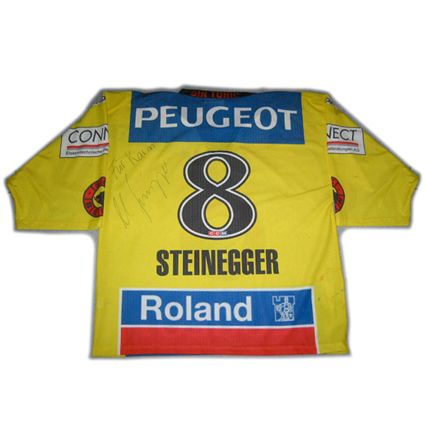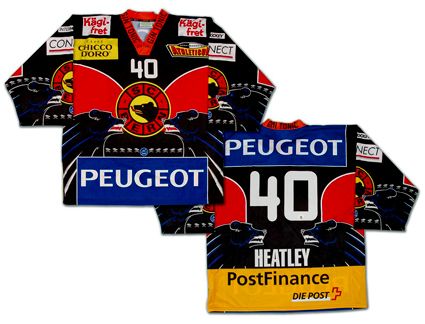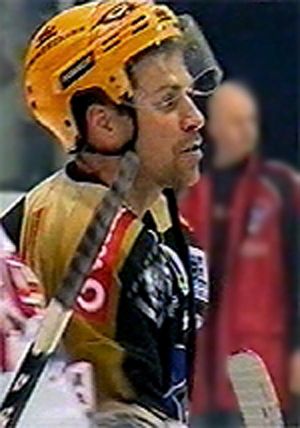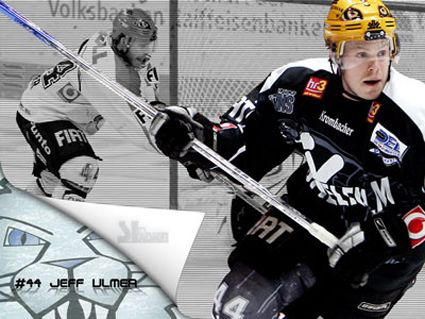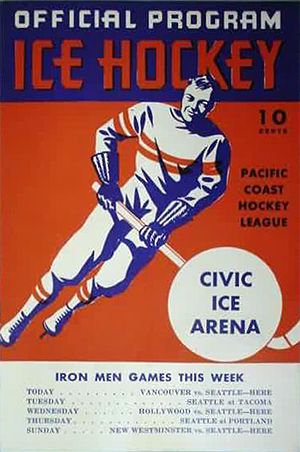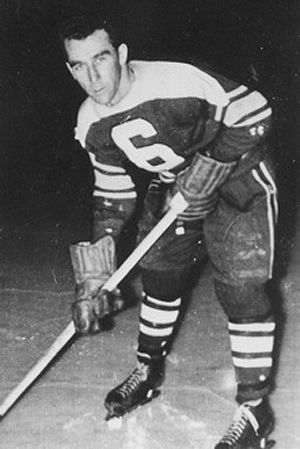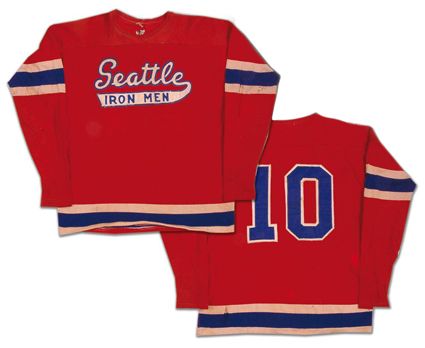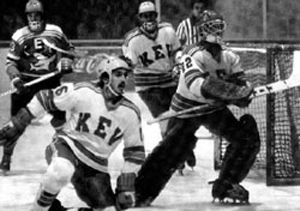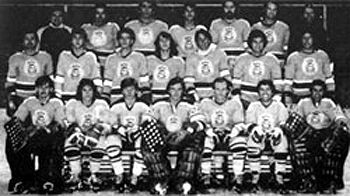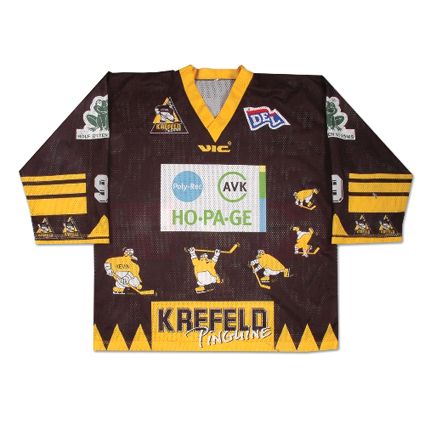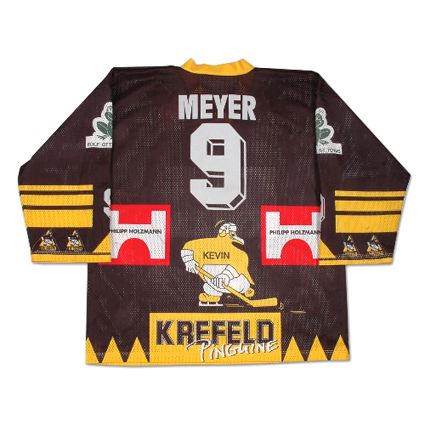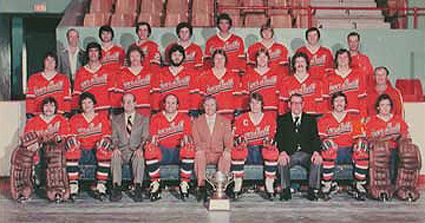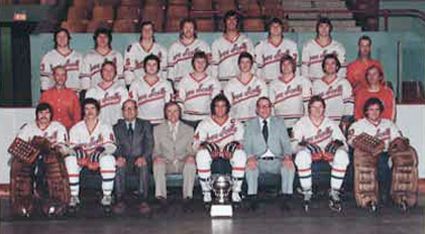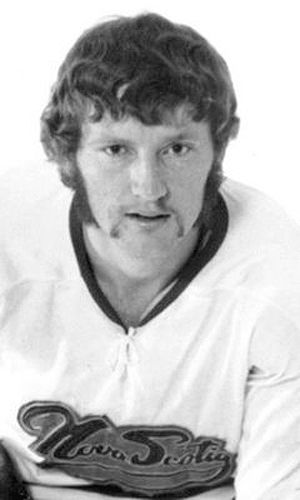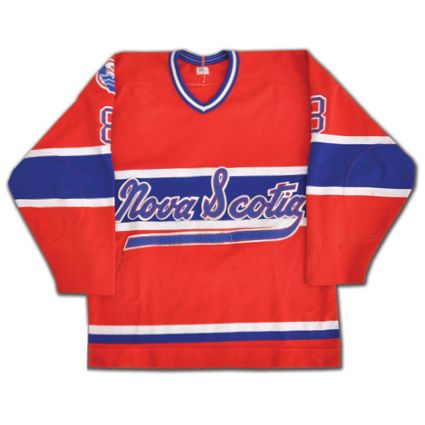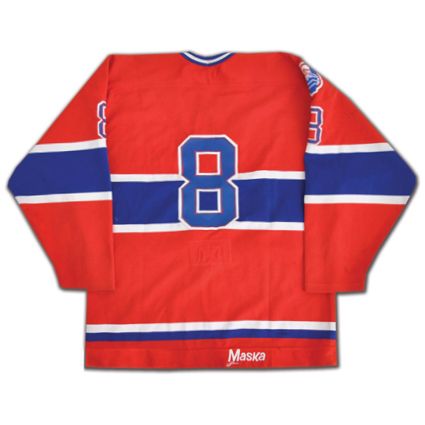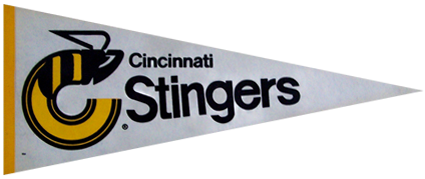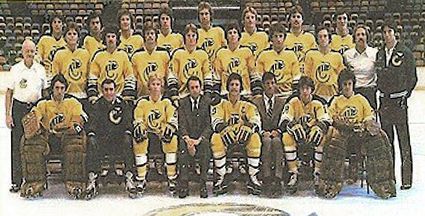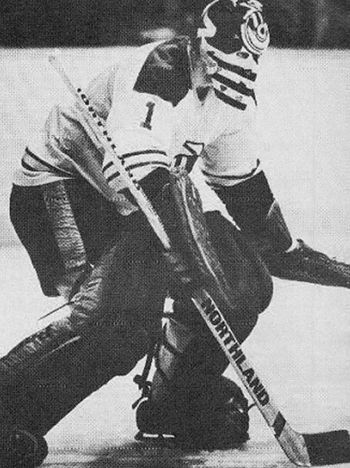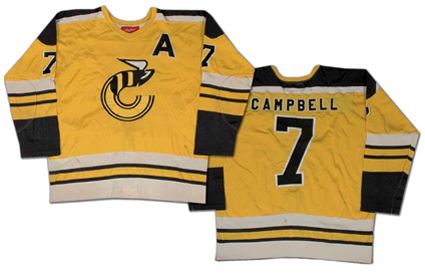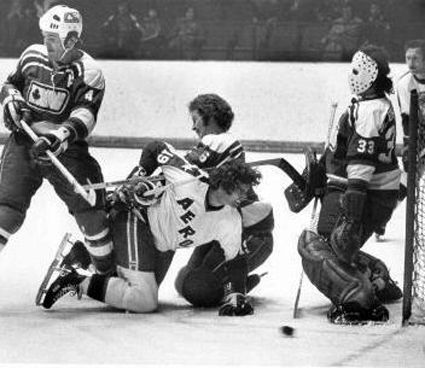Saturday, July 12, 2014
1981-82 SC Bern Roland Dellsperger Jersey
July by the Numbers travels to Switzerland for jersey #12.
Schlittschuh Club (SC) Bern (Ice-skating Club Bern in English) of Switzerland was established on November 3, 1930 and began play on January 1, 1931.
With the Swiss leagues using the promotion/relegation system, common in European soccer and hockey leagues, their first championship came in 1958 in the National League B. Newly promoted to the National League A, they captured a second championship in 1959, rising to the top of the league in absolutely the shortest time possible!
Their next championship came in 1965 after which the team was once again relegated, but won promotion again in 1969. Their time in the NLA was not to last long though and they were relegated yet again.
SC Bern regrouped once more and won their way back to the National League A in 1972, ushering in a period of great success for the club, as they won the NLA championship in 1974, 1975, 1977 and 1979. The late 1980's saw the club rise to the top once again with NLA championships in 1989, 1991 and 1992.
A tenth championship came in 1997 and they have since added titles in 2004 and 2010 for an even dozen in the National League A in addition to the three have have to their credit in the National League B.
Their success on the ice has also led to their outstanding success at the turnstiles, as SC Bern ranks as not only the club with the highest attendance in all of Europe at 15,856 per game, but in 2010-11 they ranked #22 worldwide, outdrawing nine NHL clubs on average!
This high profile also led to them being an attractive alternative to a number of NHLers during the lockout season of 2004-05, when Daniel Briere, Dany Heatley, J. P. Dumont, Marc Savard, Henrik Tallinder and Chris Clark all played for SC Bern at times.
Their competitive success also led to SC Bern being chosen to play the New York Rangers in an exhibition game in September of 2008 in advance of the first Victoria Cup.
SC Bern is also typical of many European clubs in that their jerseys have evolved over time in the area of sponsorship. This gallery takes a look at the evolution of the rise of sponsor in European hockey.
We begin with some late 1960's and 1970's jersey styles which are sponsor free.
Today's featured jersey is a 1981-82 SC Bern Roland Dellsperger jersey. This 1980's jersey is the first appearance of sponsorship we could find on an SC Bern jersey in the form of "Scheweizerische Mobiliar" across the bottom of the back of the jersey.
As the 1990's begin, the sponsorship remains rather minimal, but the jersey designs begin to become more bold and complex thanks to the dye-sublimation method of creating jersey designs.
Fast forward to the early 2000's and the sponsorships have become multiple in numbers as well as crowding the team logos on the front of the jersey. Note on the back of the jersey the player names are now subservient to the sponsor logo which now have the predominant location across the top of the back of the jersey for greater visibility.
Designs continue to evolve as the designs become more arresting and congested while the sponsorships now become a collage of colors, reducing them to a indistinguishable mass, with only the largest and boldest retaining any readability, while the team logos become harder to distinguish, as they are swallowed among the visual noise, a far cry from the pre-sponsorship days when the team logo was all that mattered.
Today's video section beings with Dany Heatley scoring a hat trick while playing for SC Bern. Note the sponsor logos are not limited to the jerseys, but also cover the players helmets, pants and socks as well as the ice.
Up next are the rabid fans of SC Bern creating at atmosphere unlike any in North America.
Finally, a feature story on Briere and Heatley while playing in Switzerland during the lockout.
Labels:
SC Bern
Friday, July 11, 2014
1999-00 Frankfurt Lions John Chabot Jersey
July by the Numbers returns to Germany for jersey #11.
Founded in 1959 as part of the Eintracht Frankfurt sports club, the Frankfurt Lions, the hockey club became it's own separate entity in 1991 and was renamed Frankfurter ESC Die Löwen (The Lions). When the DEL came into being in 1994, the club name was simplified to the Frankfurt Lions.
For their first DEL season, the Lions finished mid-pack in 10th out of 18, improving to 8th in 1995-96. A format change for the league in 1996-97 saw them finish 10th in Phase I of the season and defend their place in the DEL by defeating Ratinger Löwen in three straight games in the relegation playdowns.
A change in ownership over the summer saw new logos and colors adopted and once play began, they improved in 1997-98 to a 4th place in Phase I, before placing second in Phase II of the regular season. In the playoffs, they downed the Hannover Scorpions 3 games to 1, but were swept by defending and eventual champions Adler Manheim.
The following season they finished 4th in the regular season and won their first round playoff series in the full five games before again being knocked out in the Semifinals. 1999-00 saw a 7th place finish and a first round playoff exit before a 10th place finish in 2000-01 followed by 11th place the following season.
The 2002-03 season was a forgettable one for the Lions. They placed 13th out of 14 clubs, which forced them into the relegation playoff against the dreadful Schwenninger ERC Wild Wings, who trailed even the Lions by 25 points in the standings. Shockingly, the Wild Wings defeated the Lions 4 games to 2 to mark the Lions for demotion. The Lions were spared when the Wild Wings entered bankruptcy and had their DEL license cancelled, allowing the Lions to remain in the league after all.
Given their new lease on life, the Lions roared up the standings, raising their win total from 14 to 26 and a 5th place finish, retiring them to the playoffs thanks to league MVP and leading scorer Patrick Lebeau's 69 points. There, they knocked off the favored Cologne Sharks in six games before doing the same to the Hamburg Freezers 3 games to 2, as oddly, the first round is a best of seven, while the semifinals and finals are only a best of five. They then made the most of their second chance after being destined for relegation 12 months earlier when they defeated the Berlin Polar Bears 3 games to 1 to capture the 2004 DEL championship.
The Frankfurt Lions celebrate their 2004 DEL championship
With the 2004-05 NHL season cancelled, the Lions were able to add NHL regulars Stéphane Robidas of the Chicago Blackhawks and Doug Weight from the St. Louis Blues to their roster in mid-season. which aided the Lions in finishing first overall for the first time during the regular season with a team record 103 points from a 35-17 record. While they won their first round series, they were upset in the semifinals, costing them a chance to defend their championship.
Doug Weight while with the Lions
The club dropped to a 9th place n 2006 and came 8th in 2007, winning a preliminary round playoff series before dropping out in the first round. Success returned in 2007-08 with a 4th place finish and a quarterfinal playoff round win before dropping hard fought five game series to the Sharks, with four of the five games decided by a goal, two of which went into overtime.
Turmoil for the club began in August of 2008 when team co-founder and principal owner Gerd Schröder died at the age of 49 after having been in a coma following a stroke earlier in the year.
2008-09 had the Lions finishing 9th and then felled in the preliminary round of the playoffs. 2009-10 again saw the Lions among the league's elite teams, finishing second overall with 98 points, led by DEL scoring champion Canadian Jeff Ulmer's 37 goals and 74 points in 56 games, only to be eliminated in the quarterfinals 3 games to 1.
Jeff Ulmer
Sadly, their success on the ice was not reflected in the club's finances, and they were forced to cease operations following the 2010 playoffs, bringing to an end 51 years of hockey.
In the history of the club, Lebeau was their all time leading scorer with 307 points, 111 goals and 196 assists, tops in all three categories.
All-time leading scorer Patrick Lebeau
hoisting the 2004 championship trophy
Today's featured jersey is a 1999-00 Frankfurt Lions John Chabot jersey. While a sponsored jersey, this style still manages to maintain the Lions identity, with their Lion head logo still prominent on the front of the jersey despite being overshadowed somewhat by the Arcor logo above it.
On the back, in typical European style, the player name is below the numbers, with the PlayStation name being given top billing across the shoulders.
The jersey is very busy visually thanks more to the ten black, silver and red stripes across the front, and would be better off without the pair of black stripes behind the lion's head.
One very unique feature of the jersey is the skyline of Frankfurt appearing in the sleeve stripes, a simple and effective way to make the jersey a memorable one.
John Chabot was an NHL veteran, having played with Montreal, Pittsburgh and Detroit from 1983 to 1991 before moving to Germany where he played for nine seasons, three of which were with the Lions, where his veteran experience led to him being named team captain.
Today's video section is Lebeau scoring for the Lions scoring against the Polar Bears in the 2004 DEL finals.
Labels:
DEL,
Frankfurt Lions
Thursday, July 10, 2014
1949-50 Seattle Ironmen Pete Kalapca Jersey
July by the Numbers travels back in time to the 1950's for jersey #10.
Members of the Pacific Coast Hockey League, the Seattle Ironmen were created as an expansion franchise in time for the 1944-45 season when the league resumed play following the end of World War II.
The Ironmen broke out of the gate quickly, finishing with a league best 20-6-1 record on their way to being named league champions. Ironmen, player/coach Frank Dotten led the PCHL in both goals, with 38, and points with 72. The Ironmen then faced the Boston Olympics, and after losing the first two games, rallied to win the next four to become the United States Amateur Hockey Association champions.
Dotten would coach the Ironmen for four seasons of amateur play, including the first three as a player/coach, to three winning records in four seasons which concluded with the Ironmen finishing with the best record in the league following a 42-21-3 record for 87 points in 1947-48.
The 1947-48 Seattle Ironmen
The change to a professional league was a blow to the Ironmen, as only four players returned and they dropped to a tie for the league's worst record in 1948-49 but rebounded with a top four finish in 1949-50.
The league suffered a big loss in membership for the 1950-51 season when five of the league's 11 teams did not return for the 1950-51 season but rebounded in 1951-52 when it added three teams from the Western Canada Senior Hockey League.
One year later the league changed it's name to the Western Hockey League while the Ironmen changed their name to the Seattle Bombers, bringing and end to the Ironmen's eight year run which included one championship in the club's first season.
The Bombers would last just two seasons before running into financial difficulties and being purchased by the league and being renamed the Seattle Americans. New owners bought the club in 1958 and christened the club the Seattle Totems, who would continue to play through the 1974-75 season, ending the club's run of over 30 years.
For more on the Ironmen and the history of hockey in Seattle, please visit SeattleHockey.net.
Today's featured jersey is a 1949-50 Seattle Ironmen Pete Kalapaca jersey. This classic vintage sweater features great chain-stitching on the crest and is a great example of a cresting style that is practically a lost art today.
Despite "Iron Men" appearing as two words on the crest of the jersey and the program featured above, nearly all references online to the club show "Ironmen" as one word, including the team photo also shown above.
Today's video is a slideshow of images from the PCHL from 1944 to 1952.
Labels:
PCHL,
Seattle Ironmen
Wednesday, July 9, 2014
1996-97 Krefeld Penguins Jason Meyer jersey
July by the Numbers continues and it's back across the Atlantic for jersey #9.
Founded in 1936 as Krefelder Eislauf-Verein 1936 e.V. (KEV for short), the club, after returning after a suspension of play during World War II, won their first championship on March 12, 1952.
After struggling near the bottom of the Bundesliga for a decade and a half, thanks in part to competing with a local rival club, things really began to look up for KEV with some key acquisitions and the demise of the other Krefeld based club, KTSV Prussia in 1971.
Just as the club was knocking on the door of a title, in a shocking turn of events, ownership had overextended itself in previous seasons and the club's actual financial condition had not been accurately reported, all of which resulted in bankruptcy for KEV, which caused the German sporting authorities to revoke the team's franchise.
A new club, EHC Krefeld was formed in 1978-79, which started at the bottom of the German hockey ladder, playing in a regional league with junior players and older players, some of whom were lured back out of retirement. This club proved far stronger than their opposition, even posting a memorable 48-0 win!
The inaugural ECH Krefeld club
With the club now promoted up a level, many of the older players once again retired, their mission accomplished. New, younger players were brought in for the 1979-80 season, which resulted in a fine second place finish. Fate intervened however, as first place finisher Hamburg SV declined the opportunity to move up for financial reasons, moving EHC up the ladder once again.
When the 1980-81 season began, the club was now renamed Krefelder Eislauf-Verein 1981 e.V., reviving the name of the original club founded back in 1936. Their rise to the top division was slowed however, as the quality of competition was much stronger in the second division than it was in the third and fourth levels of the past two seasons.
The club endured for 11 seasons in the second division, and again flirted with financial problems and relegation on occasion, but persevered until the 1990-91 season, which began poorly with KEV at the bottom of the table. Bold moves were made to bring in Czech national team goaltender Karel Lang, as well as the high scoring Francois Sills and Peter Jedrus. With the revamping of the lineup complete, the wins soon followed and by the time the playoffs began, KEV had climbed to second place and their victory in the playoffs propelled the club, and once more the city of Krefeld, into the top level of the Bundesliga.
While their play on the ice was enough to keep KEV in the 1. Bundesliga, they once more faced bankruptcy in 1995, only this time a last minute reorganization allowed the club to retain it's license for the 1995-96 season, now reorganized as KEV Pinguine Eishockey GmbH, or Krefeld Pinguine (Krefeld Penguins). This was also the period of time when the Bundesliga gave way to the new DEL hockey league, ushering in a new era for German professional hockey, particularly with the ruling that made players all across Europe free agents when their current contracts expired, allowing a much greater freedom of movement for players previously unable to play in Germany.
After becoming the Krefeld Penguins and a member of the DEL, they regularly made the playoffs, reaching the postseason in five consecutive seasons. They missed the playoffs in 2001, but returned again in 2002.
While the club only managed a sixth place finish in 2002-03, the upset the DEG Metro Stars in five games before knocking out the #1 seeded Berlin Polar Bears 3-1 to reach their first ever finals despite the Polar Bears finishing 31 points higher in the regular season standings. There, they met the Cologne Sharks, the #1 overall seed. Krefeld won Games 1 & 2, but lost the next two, including Game 4 in overtime, which forced a deciding Game 5, which the Penguins won by a score of 3-1 to take the series and the championship 3 games to 2 to capture the first title in club history, second if you count the Penguins as a continuation of the first KEV club, founded back in 1936.
The Krefeld Penguins - 2003 DEL champions
During the regular season, Penguins Christoph Brandner (formerly of the Minnesota Wild) led the league with 28 goals, while teammate Brad Purdie was tops in assists with 41. Other notable names on the championship squad were future NHLer Christian Ehrhoff, Canadians and former NHLers Gary Shuchuk and Sandy Moger and the late Robert Müller in goal.
Today's featured jersey is a 1996-97 Krefeld Penguins Jason Meyer jersey. Worn shortly after the club changed their name to include the Penguins nickname, this attempt at a whimsical jersey crosses into the absurd, with with it's tumbling, celebrating penguins surrounding the main sponsor logo on the chest, which itself is an overly large, color-clashing obnoxious billboard.
Adding to the visual confusion is the main team logo of a penguin in a triangle, which is not only on the upper right chest, which would have been fine if they would have stopped there, but it is repeated in a smaller size around the cuffs, as if the five tumbling ones on the front of the jersey weren't enough already! Worse, the triangle shape is then repeated around the waist as well as another one on the cuffs for good measure. Here's an idea. If you want to repeat the team logo around the arms, how about not putting triple arm stripes of varying widths just above them to distract from them?
While we're at it, we also dislike the lousy way the team name is applied to the bottom of both the front and back, particularly the handwritten, juvenile "Pinguine" diagonally across the name of the city.
If the main sponsorship slapped on the front of the jersey like a bumper sticker wasn't bad enough, the back has a pair of bold red logos and the shoulders are adorned with winking green frogs, only adding to the mess that this jersey is!
Don't even ask us why the penguin on the right front, which is repeated larger on the back, has the name "Kevin" on it. We don't even want to know because it's certain to be stupid if we ever found out.
Later Penguins jerseys would have a certain style and flair, but this particular one is a collection of bad ideas lumped together all on one awful jersey - one with frogs and tumbling penguins, one of which is named Kevin.
Today's video section is a look at the history of the franchise in pictures and video, which captures the widely varying jerseys worn by the club in it's history, some good, some simply horrid.
Labels:
Krefeld Penguins
Tuesday, July 8, 2014
1982-83 Nova Scotia Voyageurs John Chabot Jersey
July by the Numbers visits Eastern Canada for jersey #8.
The Nova Scotia Voyaguers franchise originated in 1969 as the Montreal Voyageurs, and after two seasons in Montreal, relocated to Halifax, Nova Scotia for the 1971-72 season, becoming the first AHL team ever located in the maritime provinces of Canada.
Once in Halifax, they wasted no time and won the AHL championship in their first season following a 41-21-14 regular season record, led by Germain Gagnon's 81 points, to become the first Canadian team to ever win the Calder Cup by cruising through the playoffs with a 12-3 record and outscoring the Springfield Indians 28-6 in Round 1, the Boston Braves 15-5 in Round 2 and the Baltimore Clippers 21-8 in the finals, 64-17 all told.
The Voyaguers posted an even better record during their second season and were led by the dynamic trio of Yvon Lambert (104 points and a league leading 52 goals), Tony Featherstone (103 points and 49 goals) and Morris Stefaniw (101 points and a league leading 71 assists) who finished 1-2-3 in the AHL scoring race! In the postseason, Nova Scotia made it all the way back to the championship finals for a second year in a row.
The Voyageurs continued their winning ways for the next three seasons before returning to the Calder Cup finals in 1975-76 when they defeated the Hershey Bears in five games to win their second championship. Ron Andruff led the club in scoring with 88 points, second overall in the AHL, while leading the league in goals with 42, while teammate Guy Choiunard's 40 was second overall.
The 1975-76 AHL Calder Cup champion Nova Scotia Voyageurs
They backed their title up with the best regular season record in team history in 1976-77 with a 52-22-6 mark and were led in scoring by future Montreal Canadiens Pierre Mondu's league leading 44 goals on his way to a team leading 89 points. After defeating Hershey once again, the Voyaguers downed the Rochester Americans in six games to go back to back as Calder Cup champions, their third title in six seasons.
The 1976-77 AHL Calder Cup champion Nova Scotia Voyageurs
Four more winning seasons would follow, giving the Voyageurs ten consecutive winning seasons, a streak broken in 1981-82 when the club was an even .500 at 35-35-10.
During that time period, Norm Dube led the AHL in scoring in 1979-80 with 101 points.
After one more winning season in 1982-83, Nova Scotia would suffer their first losing season ever at 32-37-11 in what would prove to be the club's final season in Halifax before relocating to Sherbrooke, Quebec where they were once again known as the Canadiens. Subsequent moves would see the club land in Fredericton, New Brunswick before becoming the Quebec Citadelles and finally the Hamilton Bulldogs, where they still play today.
Many well known players skated for "The Vees" during their time in Halifax, including Keith Acton, Guy Carbonneau, Ken Dryden, Brian Engblom, Yvon Lambert, Pierre Mondou, Bill Nyrop and Larry Robinson.
Larry Robinson
Today's featured jersey is a 1982-83 Nova Scotia Voyageurs John Chabot jersey. This jersey takes the approach of using the main striping template of it's parent club, but adding it's own cresting to make it their own.
It's a common approach, which at times can yield fun and interesting results, but other times jerseys that are predictable and uninspired. It's a fine line between what works and what doesn't, as sometimes having the minor league team create it's own unique identity can be the way to go.
In this particular case the use of the iconic Canadiens jersey makes the unmistakeable connection to the parent club in Montreal, while the Nova Scotia cresting, complete with it's baseball style tail under the name gives it it's own unique twist, although we do have to pause and wonder why the designer did not choose to make the name red for greater contrast against the blue background.
This particular example has had the name on the back removed, a common occurrence of this time period of jersey recycling, so it may have also been worn in 1981-82 by Dan Daoust as well.
Labels:
AHL,
Nova Scotia Voyageurs
Monday, July 7, 2014
1975-76 Cincinnati Stingers Bryan Campbell Jersey
July by the Numbers checks in at #7 with a striking jersey from the World Hockey Association.
The Cincinnati Stingers were granted their franchise on May 6, 1973 but had to wait until their new home arena, the Riverfront Coliseum, was constructed before they could begin play in the 1975-76 season. The team took part in the WHA drafts while they waited for the arena to be ready, drafting Dean Talafous of Wisconsin with their first pick, and loaning out Dennis Sobchuk and John Hughes to the Phoenix Roadrunners to keep them active.
Once they had a completed home, they reclaimed their players and set out to fill their roster. They were led in scoring their first season by former Buffalo Sabre Rick Dudley, who led the team with 43 goals and 81 points in 74 games. They club finished with a respectable 35-44-1 record and only missed out on the playoffs by 2 points. Their 71 points were 12 more than the Edmonton Oilers, who somehow managed to qualify for the postseason thanks to a quirk in the always off-beat WHA!
The 1975-76 Cincinnati Stingers
Rich Leduc's 107 and Blaine Stoughton's 104 points led the Stinger attack in 1976-77 with Sobchuk right behind with 96 to place 7th, 9th and 10th in the WHA scoring race. Both Leduc and Stoughton netted 52 goals, fourth best in the league. The club finished in second place in the Eastern Conference with a team record 83 points, but were eliminated in the first round of the playoffs. That season also saw the debut of future coach and TV commentator Barry Melrose on defense. Following the season a proposed WHA merger with the NHL that would have included the Stingers was defeated by a single vote.
The 1977-78 season saw one of the more unusual jersey related occurrences in hockey history when Robbie Ftorek joined the club after the demise of the Roadrunners. Current team veteran Claude Larose had worn #8 for the past two seasons and Ftorek had also been wearing #8 as a tribute to former Boston Bruin Fleming Mackell. Neither wanted to relinquish their favorite number, so they had the team petition the league and permission was granted for both players to wear #8 during the season!
Ftorek went on to lead the club in scoring by a wide margin with 109 points, well clear of Dudley's 71. Ftorek's 59 goals were third overall in the WHA. In the standings, the Stingers finished seventh in the one-division now shrinking WHA, two points out of the playoffs.
The 1977-78 Cincinnati Stingers
Ftorek again led the team in points in 1978-79 with 116, while Peter Marsh was tops in goal scoring with 43. New, and notable additions to the Stingers roster included goalie Mike Liut, future 700 goal scorer Mike Gartner and eventual six-time Stanley Cup winner Mark Messier, who failed to impress with one goal in 47 games. Three seasons later he would score 50 for the Edmonton Oilers in the NHL.
Goaltender Mike Liut
The Stingers were eliminated from the playoffs in Round 1, two games to one by the New England Whalers, but not before winning their one and only playoff game in team history 6-3 at home in Game 2.
Following the season, the WHA agreed to a one-sided merger plan with the NHL, which allowed Winnipeg, New England, Quebec and Edmonton to join the NHL as expansion franchises, while the owners of both Cincinnati and the Birmingham Bulls were given a cash payment of $3.15 million as a buy-out, putting an end to the Stingers franchise after just four years on the ice.
Today's featured jersey is a 1975-76 Cincinnati Stingers Bryan Campbell jersey. With the Stingers name lending itself to a multi-stripe theme, it's a wonder the Stingers jerseys were as reserved as they were.
The Stingers logo is a wonderful piece of graphic design and looks as modern today as it did when it was first conceived and has always been one of our favorites.
Our first video is a profile of former Stinger Blaine Stoughton.
Here is amateur footage of the minor league Cincinnati Clyclones playing while wearing Stingers throwback jerseys.
Labels:
Cincinnati Stingers,
WHA
Sunday, July 6, 2014
1972-73 Ottawa Nationals Brian GIbbons Jersey
July by the Numbers once again crosses the continent for jersey #6.
When plans began to take place for the inaugural season of the World Hockey Association in 1972-73, the league naturally wanted to have a club located in Toronto, but they ran into a road block of the most stubborn kind in the form of Harold Ballard, the cantankerous owner of the Toronto Maple Leafs and, more importantly, their arena, Maple Leaf Gardens.
When no deal was able to be reached with Ballard, the franchise earmarked for Toronto was instead placed in the capital of Ottawa after an attempt to locate the club in Hamilton. The Nationals failed to lure any top-flight NHL talent to Ottawa, such as Brad Park, Dave Keon or Eddie Shack, all of whom were on their draft list, due to their late start in finding a home, but Wayne Carlton was signed away from the California Golden Seals, one of several players the Seals lost to the upstart WHA, and led the club with 42 goals and 91 points.
The Nationals leading scorer Wayne Carlton
The goaltending duties where handled by rookie Gilles Gratton, who was backed up by former Pittsburgh Penguin veteran Les Binkley. Gavin Kirk and Bob Charlebois each scored more than 60 points while Brian Gibbons led all defensemen in scoring with 42 points while Rick Cunningham led the team with 121 penalty minutes.
Gilles Gratton guards the Nationals goal
After losing their first three games, the Nationals won their next four. They spent their first three months hovering around the .500 mark, closing out December with a 16-18-3 record, which included a pair of four game winning streaks.
January was unkind to the Nationals, who dropped 11 out of 14 to fall to 19-29-3. After going 6-7-1 in February, the Nationals caught fire and roared through March with a spectacular run, winning 11 of 12 to force themselves back into the playoffs, with their 74 points edging the Quebec Nordiques at 71.
Despite Ottawa not having had top level professional hockey since the once-dominant Ottawa Senators left the capital in 1934, attendance proved to be an issue, as the team drew an average of just 3,226 fans per game in the 9,000 seat Ottawa Civic Centre while competing with the established and quite popular Ottawa 67's junior club of the Ontario Hockey Association.
The Nationals were paired with the first place New England Whalers in the opening round of the post season, however...
...the City of Ottawa demanded a payment of $100,000 to secure dates for the following season prior to the playoffs, which prompted the club's ownership to consider their options which resulted in them choosing to move all their "home" playoff games to Toronto!
Now known as the Ontario Nationals during the playoffs, they lost their first two games 6-3 and 4-3 in Boston. The Nationals returned "home" to face the New England Whalers and won Game 3 by a score of 4-2, but lost Game 4 by a decisive 7-3 score while averaging 5,000 fans a game. The Whalers closed out the series with a 5-4 win back in Boston to end the Nationals season, and as it turned out, the Nationals themselves, as the team was sold following the season to John Bassett, who made Toronto their permanent home and renamed the team the Toronto Toros in June of 1973.
Today's featured jersey is a 1972-73 Ottawa Nationals Brian Gibbons jersey as worn during the Nationals only season in Ottawa. This is a very attractive jersey for it's day and the addition of the extra blue stripe trimmed in white just under the shoulder yoke makes it very unique. We especially like the white name on the red nameplate placed directly on top of that stripe.
The team logo is also very bold and well executed, although we always felt it looked more like a corporate logo, for a railroad in particular, rather than a pro hockey team.
Still, a very nice jersey and one that lived an all too short life.
Here is a history of the formation of the WHA and some of the first players to join the upstart league.
Labels:
Ottawa Nationals,
WHA
Subscribe to:
Comments (Atom)



